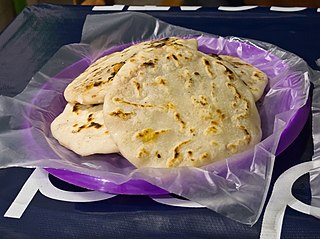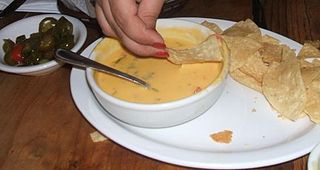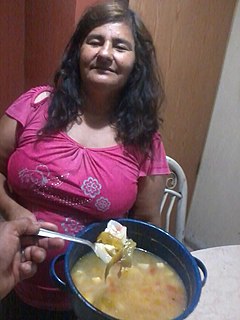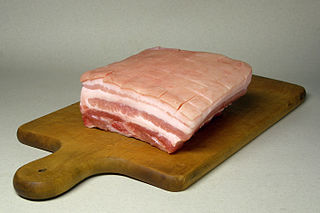
Tostada is a Spanish word meaning "toasted". In Mexico and other parts of Latin America, it is the name of various local dishes which are toasted or use a toasted ingredient as the main base of their preparation.

A quesadilla, or sometimes specifically a cheese quesadilla, is a Mexican dish, consisting of a tortilla that is filled primarily with cheese, and sometimes meats, beans, vegetables, and spices, and then cooked on a griddle. Traditionally, a corn tortilla is used, but it can also be made with a flour tortilla, particularly in northern Mexico and the United States.

Cachapas is the Spanish word for "crumpets" and are a traditional Venezuelan dish made from corn. Like arepas, they are popular at roadside stands. They can be made like pancakes of fresh corn dough, or wrapped in dry corn leaves and boiled. The most common varieties are made with fresh ground corn mixed into a thick batter and cooked on a budare, like pancakes; the cachapa is slightly thicker and lumpier because of the pieces from corn kernels.

Salvadoran cuisine is a style of cooking derived from the nation of El Salvador. The traditional cuisine consists of food from Native American cuisine, indigenous Lenca, Pipil and European Spanish peoples. Many of the dishes are made with maize (corn).

Oaxaca cheese more commonly referred to as Quesillo is a white, semihard cheese from Mexico, similar to unaged Monterey jack, but with a mozzarella-like string cheese texture. Outside Mexico, Oaxaca cheese is often confused with asadero, a cheese produced in the northern state of Chihuahua. They are similar in texture and taste, but they are produced with different methods, making Oaxaca cheese slightly drier.

Chicharrón is a dish generally consisting of fried pork belly or fried pork rinds. Chicharrón may also be made from chicken, mutton or beef.

Queso blanco, with similar cheeses including queso fresco, is a creamy, soft, and mild unaged white cheese, commonly used in the Iberian Peninsula, several Latin American countries including Mexico, and many parts of the United States. The name queso blanco is Spanish for "white cheese", but similar cheeses are used and known throughout the world. In Brazil they are respectively known as queijo branco and queijo fresco in Portugal.

A gordita in Mexican cuisine is a pastry made with masa and stuffed with cheese, meat, or other fillings. It is similar to a pasty and to the Colombian/Venezuelan arepa. Gordita means "chubby" in Spanish. There are two main variations of this dish, one which is typically fried in a deep wok-shaped comal, consumed mostly in central and southern Mexico, and another one baked on a regular comal. The most common and representative variation of this dish is the "gordita de chicharrón", filled with chicharron which is widely consumed throughout Mexico. Gorditas are often eaten as a lunch meal and accompanied by several types of sauce.

The chile relleno is a dish in Mexican cuisine that originated in the city of Puebla.

Chile con queso, sometimes described simply as queso, is an appetizer or side dish of melted cheese, or more usually, a pasteurised processed cheese food product such as Velveeta, and chili pepper typically served in Tex-Mex restaurants as a dip for tortilla chips.

A mollete refers to an open-faced sandwich in Mexican cuisine or to a type of bread in Spanish cuisine.

Cuchifritos refers to various fried foods prepared principally of pork in Spanish and Puerto Rican Cuisine. In Spain, cuchifritos are a typical dish from Andalusia and Extremadura. Also called cochifritos, the dish consists of pork meat fried in olive oil and garlic and served hot. In Puerto Rico they include a variety of dishes including morcilla, papas rellenas, chicharron, and other parts of the pig prepared in different ways. Some cuchifritos dishes are prepared using plantain as a primary ingredient. Cuchifritos vendors also typically serve juices and drinks such as passionfruit, pineapple, and coconut juice, as well as ajonjolí, a drink made from sesame seeds.

Pambazo is the name of a Mexican wet sandwich. It is also the name of the dish or antojito made with this bread dipped in a red guajillo pepper sauce and filled with papas con chorizo.
Pastel is the name given to different typical dishes invented by Chinese expats in Brazil.

Cheeses in Mexico have a history that begins with the Spanish conquest, as dairy products were unknown in pre-Columbian Mesoamerica. The Spanish brought dairy animals, such as cattle, sheep, and goats, as well as cheesemaking techniques. Over the colonial period, cheesemaking was modified to suit the mixed European and indigenous tastes of the inhabitants of New Spain, varying by region. This blending and variations have given rise to a number of varieties of Mexican cheeses. These are most popular in the country, although European cheeses are made, as well. Almost all cheese in Mexico is made with cows’ milk, with some made from goats’ milk. More recently, efforts have been made to promote sheep’s milk cheeses. Most cheeses are made with raw (unpasteurized) milk. Cheeses are made in the home, on small farms or ranches, and by major dairy product firms. Between 20 and 40 different varieties of cheese are made in Mexico, depending on how one classifies them. Some, such as Oaxaca and panela, are made all over Mexico, but many are regional cheeses known only in certain sections on the country. Some of the least common are in danger of extinction.

Krupuk kulit is a traditional Indonesian cattle skin krupuk (cracker). Traditionally it is made from the soft inner skin of cattle, diced, and sun-dried until it hardens and loses most of its water content. The diced and dried skin are later fried in ample hot cooking oil until they expand in similar fashion with bubble and yield a crispy texture. This fried cattle skin is then sealed in vacuum plastic bags to ensure and prolong its crispiness.

Caldo de queso is a traditional queso (cheese) soup made in places in Hermosillo, Sonora.

Pork rind is the culinary term for the skin of a pig. It can be used in many different ways.































